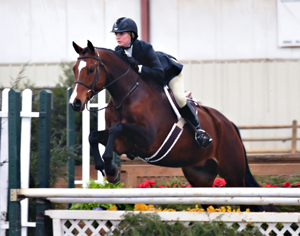Are you considering joining an Intercollegiate Horse Show Association riding team in college? Here are a few particulars of IHSA competition you need to know before you show.

How much time do IHSA competitors have to ride their drawn horses in the warm-up area before going into the ring?
Usually, very little time is available for a rider to get to know a horse before going into the ring. During the preceding class, riders are to mount their horses and walk them around?no trotting, no collection. It’s just enough time to address stirrup length and to get a feel for a horse. Walking in the small warm-up area is the only preparation a rider has. Coaches and others may help with stirrups and give last-minute instructions.
How much time is there between the horse draw and the actual competition? Before they get on, can riders request feedback from the home team riders who know the horse? If so, what sort of questions would you recommend asking?
In our region (Zone IV, Region 2), except for one school, the draw is done one class prior to a rider’s class. The rider may mount after drawing the name, unless the horse is in the ring. In that case, the rider has the advantage of watching his or her horse being ridden. In many regions the draw is done during the coaches’ meeting preceding the horse show. After the draw, riders may see what horse they are going to ride and in many cases watch it be shown. There are times when a horse may be resistant to the show ring or for some other reason have to be pulled, in which case a replacement for that horse will be announced.
I find that, without exception, coaches, trainers and riders from a host school are very willing to give riders from other schools help and advice about a horse. Before a show many of the horses will be schooled over a course of jumps, and it is a big advantage to see those horses go. In addition, you’ll find a list at every show that catalogs each horse’s mannerisms: the need for a crop or spurs, for example, or a drift or other type of behavior that a rider might need to be aware of.
There are many questions riders ask at the horse shows, but the usual ones are about canter aids, how a horse reacts to other horses around him, and whether when jumping the horse will get down the lines and change leads comfortably. Another good question is whether the horse show allows simple change of leads in the jumping classes.
The whole reason for these shows is to allow riders to compete safely in a college varsity sport for a national title. As individuals or as a team, riders compete at different levels, from beginners to riders who have competed in Jumper classes. It’s the only sport in which a beginner or a novice in a sport can compete at the varsity level to be on a nationally ranked team.
Nancy Peterson has instructed riding students at Hollins University in Roanoke, Virginia, since 1972. Among many of her achievements and awards, she received the 2007 IHSA Lifetime Achievement Award and was named the 2004 Virginia Horse Show Association Horseperson of the Year and the Old Dominion Athletic Conference Coach of the Year five times. Currently the director of riding at Hollins, Nancy has guided the team to fourth place in the IHSA Collegiate Cup Hunter Seat Team Championships in 2004 and 2010 and sixth place in 2005. In the recent 2010-11 season, the Hollins riding team won its second straight and record 19th ODAC title, and Sarah Jarosinski ’12 was the IHSA Individual Novice Equitation Over Fences national reserve champion.
Read more from Nancy about intercollegiate riding in Here’s How in the December 2011 issue of Practical Horseman magazine.










